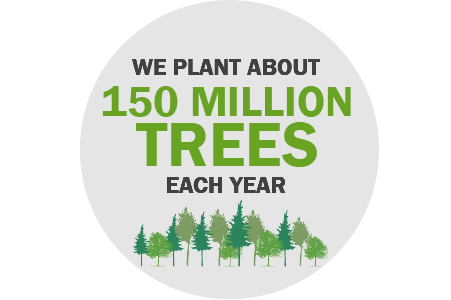 Sustainable Forestry
Sustainable Forestry
For generations to come
We believe forests can be managed sustainably, forever. As one of the world's largest private timberland owners, we turn this belief into action. In the United States, we own or have long-term leases on more than 12 million acres of timberlands in the Pacific Northwest, the Northeast and the South. In Canada, we manage millions of acres of publicly owned land under long-term provincial licenses. Our entire timberland portfolio is certified to the Sustainable Forestry Initiative® Forest Management standard.
We responsibly manage our forests to ensure a sustainable supply of wood for our customers, today and in the future, while protecting the other important benefits forests provide, such as clean water, clean air and habitat for wildlife. We understand the importance of being a responsible forest owner and we've been doing just that for a long time:
- We advocated for legislation in 1925 to encourage reforestation after harvest, which was an uncommon practice at the time.
- In 1937, we began research into sustainable yield forestry, which ensures harvesting doesn't diminish the forest's ability to provide the same volume in the future.
- In 1938, we were one of the first companies to plant tree seedlings. From this effort, a new crop was born and Weyerhaeuser's tree-planting era began.
- In 1941, we established the first certified tree farm in the United States located on 120,000 acres of harvested and fire-burned land in Washington state.
- We planted our 2 billionth seedling in 1986. The seedling was planted in the blast zone of Mount St. Helens to commemorate the completion of a restoration effort in which 18 million seedlings were planted.
- Last year, we planted close to 150 million seedlings in our harvested sites, equivalent to 5 trees per second.
WE HARVEST AND REPLANT
Today, we practice intensive silviculture to improve forest productivity, including planting tree seedlings to reforest harvested areas and monitoring and caring for these planted trees as they grow to maturity.
Averaging across our regions, we harvest about 2 percent of our forests each year. This equates to roughly only 20 of every 1,000 acres of forests we own or manage being harvested each year — which means the other 98 percent are either continuing to grow or are being replanted.
The vast majority of our harvested sites are reforested by directly planting tree seedlings in the ground. On average, we replant 97 percent of harvested sites within two years or growing seasons. On the remaining sites, we use natural regeneration where we let new trees grow from seeds that fall from existing trees. When we rely on natural regeneration, we ensure successful regeneration of these forests within five years or growing seasons.
Guided By Policies and Research
We have robust internal policies and management systems that guide our sustainable forestry practices, most notably our Sustainable Forestry Policy and our certification to the SFI Forest Management standard.
We believe sustainable forestry requires continuous improvement based on sound science and innovation. We have a world-class internal research program, heavily invest in outside research and collaborate with many other partners to help improve the practice of sustainable forestry. The results of this research enable us to continually improve our methods for growing, harvesting and replanting our forests while preserving the conservation and environmental benefits they provide. In 2018, we invested more than $9 million in research related to forest health and productivity, water quality and biodiversity. While we invest in traditional tree breeding programs, we do not participate in research to genetically engineer or modify our trees via biotechnology processes.
MORE THAN JUST TIMBER
In addition to a reliable and sustainable supply of wood fiber, our forests provide unique environmental, cultural and recreational value. Our practices ensure we protect these benefits, including habitat for wildlife, functioning and healthy ecosystems for clean air and water, access to recreation for our communities and many other ecosystem services.
We partner with local, regional, national and global nonprofits, research organizations, universities and government agencies to support research, monitoring and outreach about sustainable forestry, best management practices, tree improvement, climate science and much more.

WHAT IS SUSTAINABLE FORESTRY?
We think this video, produced by forestinfo.org, is a great and fun introduction.
By using this website, you agree to our Privacy Policy. California residents: See our CCPA Privacy Notice for details on what personal information we collect and for what purposes.
